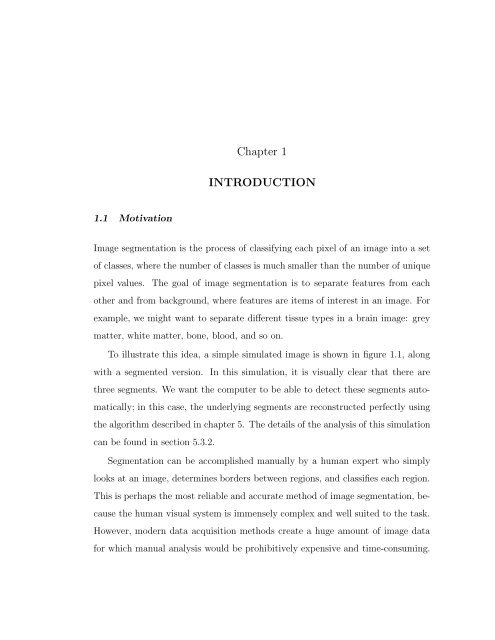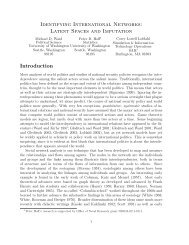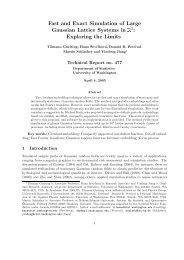- Page 1: Fast Automatic Unsupervised Image S
- Page 5: In presenting this dissertation in
- Page 9 and 10: TABLE OF CONTENTSList of FiguresLis
- Page 11 and 12: 4.1.2 Penalty Adjustment . . . . .
- Page 13 and 14: Appendix A: Software Discussion 169
- Page 15 and 16: 4.1 (a) Signal generated by an AR(1
- Page 17 and 18: 5.29 Aerial image of a buoy, before
- Page 19: DEDICATIONThis work is dedicated to
- Page 23 and 24: 3without training data (unsupervise
- Page 25 and 26: 5not be generally applicable, thoug
- Page 27 and 28: Chapter 2CLUSTERING ON OPEN PRINCIP
- Page 29 and 30: 92.2 Model, Estimation and Inferenc
- Page 31 and 32: 11where L(x i |θ) = ∑ Kj=1 π j
- Page 33 and 34: 13ness of a feature) considered is
- Page 35 and 36: 15thogonal distance to the curve),
- Page 37 and 38: ••••17•• •• ••
- Page 39: 19Table 2.1: BIC results for the tw
- Page 42 and 43: 22Figure 2.8: Initial clustering of
- Page 44 and 45: 24Latitude35.5 36.0 36.5 37.0 37.5
- Page 46 and 47: 26Latitude35.5 36.0 36.5 37.0 37.5
- Page 48 and 49: 282.5 DiscussionWe have introduced
- Page 50 and 51: 30transform type of approach. The e
- Page 52 and 53: 32curve. Extending the method to ac
- Page 54 and 55: 34is to use a likelihood ratio test
- Page 56 and 57: 36The error of the approximation in
- Page 58 and 59: 38the image with this independence
- Page 60 and 61: 403.4.1 Mixture versus Componentwis
- Page 62 and 63: 42P (X i = m|Y i ) ∝ P (Y i |X i
- Page 64 and 65: 44In finding argmax C g(C|X), we ca
- Page 66 and 67: 46fine tuning of this. For instance
- Page 68 and 69: 48is σ 2 Y .Independence CaseWhen
- Page 70:
50L(Y −1 |M, Y 1 ) = − N − 12
- Page 73 and 74:
53analysis. We now consider g ′
- Page 75 and 76:
55g(θ) ≈ log(p(Y |θ, M)) (4.38)
- Page 77 and 78:
574.2 Adjusting BIC for the Raster
- Page 79 and 80:
59ˆσ 2 ɛ = 1N 0 − 1∑(Y i −
- Page 81 and 82:
61E[(Y i − µ)(Y (i−j) − µ)]
- Page 83 and 84:
63The dependence model uses additio
- Page 85 and 86:
65(BIC(K) = 2 L IND (Y −B | θ ˆ
- Page 87 and 88:
67number of pixels minus the number
- Page 89 and 90:
69in figure 4.1B). This problem cau
- Page 91 and 92:
Chapter 5AUTOMATIC IMAGE SEGMENTATI
- Page 93 and 94:
73the Gaussian parameters ˆθ, whi
- Page 95 and 96:
75f( ˆX|Y, ˆφ, ˆθ) ∝ ∏ if(
- Page 97 and 98:
77After running ICM, we have an est
- Page 99 and 100:
79denoted by µ K and σK; 2 equati
- Page 101 and 102:
81∫ ∞−∞|g i (Y i )|f(Y i )d
- Page 103 and 104:
83Lemma 2: ErgodicityLet X = X i ,
- Page 105 and 106:
85both dimensions) we are asymptoti
- Page 107 and 108:
87⎛∑ Kj=1f(YE KT⎝i |X i = j,
- Page 109 and 110:
89⎛∑ ∑ KTlog ⎝ j=1 f(Y i |X
- Page 111 and 112:
91− ∑ (Y i − µ 2 ) 2i∈S 22
- Page 113 and 114:
935.2 An Automatic Unsupervised Seg
- Page 115 and 116:
95has at least T 0 pixels. The proc
- Page 117 and 118:
97is the number of components (this
- Page 119 and 120:
99ˆµ j =∑ Ci=1H i ˆR ij V i∑
- Page 121 and 122:
101However, experience with the EM
- Page 123 and 124:
103log L ˆX (Y |K) = ∑ ilog(f(Y
- Page 125 and 126:
105operation. Then erosion can be e
- Page 127 and 128:
107is found; this results in a much
- Page 129 and 130:
1090 10 20 30 400 10 20 30 40Figure
- Page 131 and 132:
1115.3.2 Simulated Three Segment Im
- Page 133 and 134:
1130 10 20 30 40 50 600 10 20 30 40
- Page 135 and 136:
115Percent0.0 0.002 0.004 0.006 0.0
- Page 137 and 138:
1170 10 20 30 40 50 600 10 20 30 40
- Page 139 and 140:
1190 10 20 30 40 50 600 10 20 30 40
- Page 141 and 142:
121only one possible melt pool is e
- Page 143 and 144:
123Table 5.5: EM-based parameter es
- Page 145 and 146:
1250 20 40 60 80 1000 20 40 60 80 1
- Page 147 and 148:
1270 20 40 60 80 1000 20 40 60 80 1
- Page 149 and 150:
1290 20 40 60 80 1000 20 40 60 80 1
- Page 151 and 152:
131artifacts as well.The ICM refine
- Page 153 and 154:
133Table 5.7: EM-based parameter es
- Page 155 and 156:
1350 20 40 60 80 100 1200 20 40 60
- Page 157 and 158:
1370 20 40 60 80 100 1200 20 40 60
- Page 159 and 160:
1395.3.5 Washington CoastFigure 5.2
- Page 161 and 162:
141Table 5.8: Logpseudolikelihood a
- Page 163 and 164:
143Percent0.0 0.02 0.04 0.06 0.080
- Page 165 and 166:
1450 20 40 60 80 100 1200 20 40 60
- Page 167 and 168:
1470 20 40 60 80 100 1200 20 40 60
- Page 169 and 170:
149visible, both in jagged horizont
- Page 171 and 172:
151Table 5.11: EM-based parameter e
- Page 173 and 174:
153Percent0.0 0.02 0.04 0.06 0.080
- Page 175 and 176:
1550 20 40 60 80 1000 20 40 60 80 1
- Page 177 and 178:
1570 20 40 60 80 1000 20 40 60 80 1
- Page 179 and 180:
159The image segmentation examples
- Page 181 and 182:
161to provide predictive inference
- Page 183 and 184:
163Campbell, N.W., Mackeown, W.P.J.
- Page 185 and 186:
165Hartigan, J. A. (1975). Clusteri
- Page 187 and 188:
167Prim, R. (1957), “Shortest Con
- Page 189 and 190:
Appendix ASOFTWARE DISCUSSIONA.1 XV
- Page 191 and 192:
171emoutput.txt, emimageout.pgm.emn
- Page 193 and 194:
173unique data values, so it can ha
















